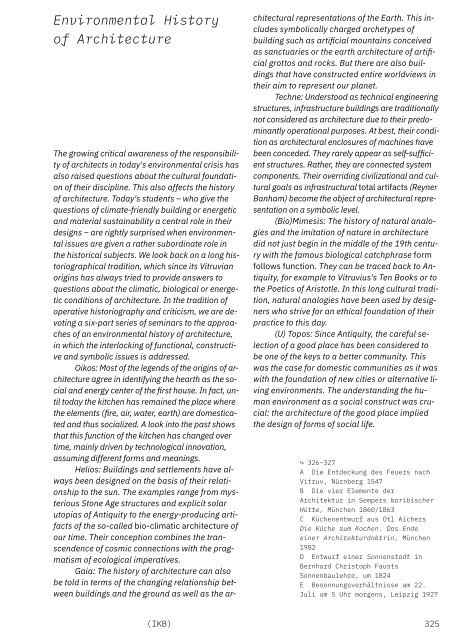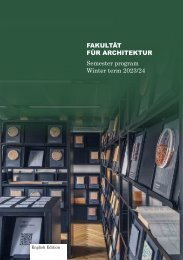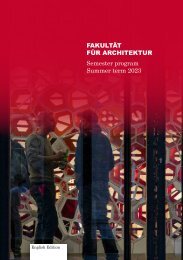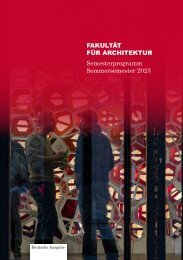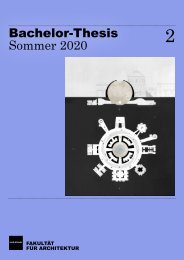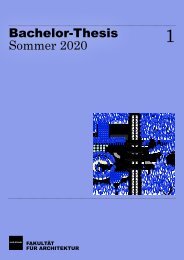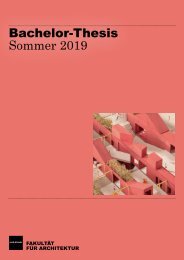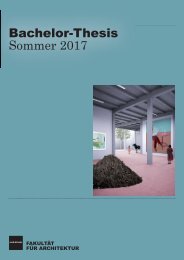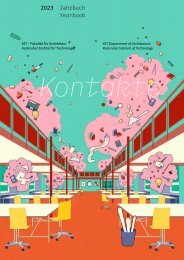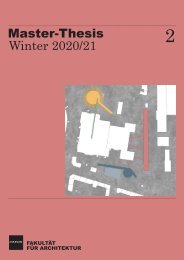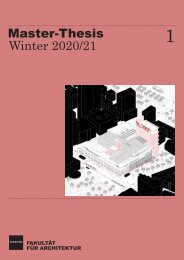Salutogenese – Das Jahrbuch der KIT-Fakultät für Architektur 2021
Im Oktober 2021 ist das neue Jahrbuch der Fakultät erschienen: 374 Seiten Diskurs, Dokumentation und Data aus Lehre, Forschung und Fakultätsleben. In deutsch und englisch.
Im Oktober 2021 ist das neue Jahrbuch der Fakultät erschienen: 374 Seiten Diskurs, Dokumentation und Data aus Lehre, Forschung und Fakultätsleben. In deutsch und englisch.
Sie wollen auch ein ePaper? Erhöhen Sie die Reichweite Ihrer Titel.
YUMPU macht aus Druck-PDFs automatisch weboptimierte ePaper, die Google liebt.
Environmental History<br />
of Architecture<br />
The growing critical awareness of the responsibility<br />
of architects in today's environmental crisis has<br />
also raised questions about the cultural foundation<br />
of their discipline. This also affects the history<br />
of architecture. Today's students – who give the<br />
questions of climate-friendly building or energetic<br />
and material sustainability a central role in their<br />
designs – are rightly surprised when environmental<br />
issues are given a rather subordinate role in<br />
the historical subjects. We look back on a long historiographical<br />
tradition, which since its Vitruvian<br />
origins has always tried to provide answers to<br />
questions about the climatic, biological or energetic<br />
conditions of architecture. In the tradition of<br />
operative historiography and criticism, we are devoting<br />
a six-part series of seminars to the approaches<br />
of an environmental history of architecture,<br />
in which the interlocking of functional, constructive<br />
and symbolic issues is addressed.<br />
Oikos: Most of the legends of the origins of architecture<br />
agree in identifying the hearth as the social<br />
and energy center of the first house. In fact, until<br />
today the kitchen has remained the place where<br />
the elements (fire, air, water, earth) are domesticated<br />
and thus socialized. A look into the past shows<br />
that this function of the kitchen has changed over<br />
time, mainly driven by technological innovation,<br />
assuming different forms and meanings.<br />
Helios: Buildings and settlements have always<br />
been designed on the basis of their relationship<br />
to the sun. The examples range from mysterious<br />
Stone Age structures and explicit solar<br />
utopias of Antiquity to the energy-producing artifacts<br />
of the so-called bio-climatic architecture of<br />
our time. Their conception combines the transcendence<br />
of cosmic connections with the pragmatism<br />
of ecological imperatives.<br />
Gaia: The history of architecture can also<br />
be told in terms of the changing relationship between<br />
buildings and the ground as well as the architectural<br />
representations of the Earth. This includes<br />
symbolically charged archetypes of<br />
building such as artificial mountains conceived<br />
as sanctuaries or the earth architecture of artificial<br />
grottos and rocks. But there are also buildings<br />
that have constructed entire worldviews in<br />
their aim to represent our planet.<br />
Techne: Un<strong>der</strong>stood as technical engineering<br />
structures, infrastructure buildings are traditionally<br />
not consi<strong>der</strong>ed as architecture due to their predominantly<br />
operational purposes. At best, their condition<br />
as architectural enclosures of machines have<br />
been conceded. They rarely appear as self-sufficient<br />
structures. Rather, they are connected system<br />
components. Their overriding civilizational and cultural<br />
goals as infrastructural total artifacts (Reyner<br />
Banham) become the object of architectural representation<br />
on a symbolic level.<br />
(Bio)Mimesis: The history of natural analogies<br />
and the imitation of nature in architecture<br />
did not just begin in the middle of the 19th century<br />
with the famous biological catchphrase form<br />
follows function. They can be traced back to Antiquity,<br />
for example to Vitruvius's Ten Books or to<br />
the Poetics of Aristotle. In this long cultural tradition,<br />
natural analogies have been used by designers<br />
who strive for an ethical foundation of their<br />
practice to this day.<br />
(U) Topos: Since Antiquity, the careful selection<br />
of a good place has been consi<strong>der</strong>ed to<br />
be one of the keys to a better community. This<br />
was the case for domestic communities as it was<br />
with the foundation of new cities or alternative living<br />
environments. The un<strong>der</strong>standing the human<br />
environment as a social construct was crucial:<br />
the architecture of the good place implied<br />
the design of forms of social life.<br />
↪ 326–327<br />
A Die Entdeckung des Feuers nach<br />
Vitruv, Nürnberg 1547<br />
B Die vier Elemente <strong>der</strong><br />
<strong>Architektur</strong> in Sempers karibischer<br />
Hütte, München 1860/1863<br />
C Küchenentwurf aus Otl Aichers<br />
Die Küche zum Kochen. Das Ende<br />
einer <strong>Architektur</strong>doktrin, München<br />
1982<br />
D Entwurf einer Sonnenstadt in<br />
Bernhard Christoph Fausts<br />
Sonnenbaulehre, um 1824<br />
E Besonnungsverhältnisse am 22.<br />
Juli um 5 Uhr morgens, Leipzig 1927<br />
(IKB)<br />
325


